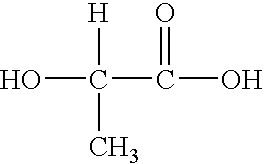Treatment of animal carcasses
a technology for animal carcasses and cleaning, applied in the field of animal carcasses treatment, can solve the problems of unsanitary and time-consuming task of cleaning carcasses in the preparation of any food product, affecting the quality of carcass meat, and retaining carcass meat, so as to reduce the microbial population, prevent browning of meat carcasses, and fast vent and cool
- Summary
- Abstract
- Description
- Claims
- Application Information
AI Technical Summary
Benefits of technology
Problems solved by technology
Method used
Image
Examples
working examples
[0086] The invention will now be described in more detail by reference to the following working examples. The only proper construction of these examples is as nonlimiting, illustrative example showing various formulations, stabilities, and applications of the invention.
Test Formula #1MaterialWeight PercentDeionized water53.9Mixed Peroxycarboxylic acids14.75Hydrogen Peroxide6.9Acetic Acid25.0Octanoic Acid3.5Hydroxyethylidene-1,1-diphosphonic acid0.95Sodium Octane mixed Mono- and Di-Sulfonate5.0
working example # 1
Working Example #1
[0087] The objective of working example #1 was to determine if 0.5% and 1.0% lactic acid alone and in combination with Test Formula #1 and / or steam achieved a reduction in the bacterial flora present on prerigor beef samples. An exposure time of 10 minutes was utilized for all applications and testing was performed at 33° C.
Operating Procedure:
[0088] Sixteen prerigor beef samples were obtained and kept in a cooler until time of testing. Samples were aseptically divided in half. Eight different test treatments were utilized with four replicate pieces per treatment with the exception of the steam +0.5% lactic acid treatment which only had three replicate pieces. Two cores (4.3 cm diameter) were taken from each replicate piece before and after treatment, combined into 99 mL of Phosphate Buffered Dilution water, stomached for 1 minutes and then serially diluted and plated using pour plate technique.
Test Products:1.Test Formula #1 at 200 ppm Total Peracid2.Test For...
working example # 2
Working Example #2
[0094] The objective of the testing was to determine the efficacy of various antimicrobial treatments with extended spray and exposure times against the bacterial flora of prerigor beef.
Test Method / Parameters:
[0095] Prerigor beef samples were obtained and kept in a cooler at ambient temperature until time of testing. Ten different test treatments were utilized with four replicates per treatment. Two cores (4.3 cm diameter) were taken as each replicate from one piece for both before- and after-treat samples and combined into 99 mL of Letheen Broth. The cores / neutralizer mixtures were stomached for 1 minute and then serially diluted and plated using pour plate technique. [0096] Test Products: [0097] Test Formula #1* at 200 ppm Peracid=0.42% (4.2 mL were added to 995.8 mL tap water) [0098] Test Formula #1* at 500 ppm Peracid (10.5 mL were added to 989.5 mL tap water) [0099] 0.5% Lactic Acid [0100] *Test Formula #1, batch # Si120972, was titrated at 4.76% total pera...
PUM
| Property | Measurement | Unit |
|---|---|---|
| temperature | aaaaa | aaaaa |
| temperature | aaaaa | aaaaa |
| pressure | aaaaa | aaaaa |
Abstract
Description
Claims
Application Information
 Login to View More
Login to View More - R&D
- Intellectual Property
- Life Sciences
- Materials
- Tech Scout
- Unparalleled Data Quality
- Higher Quality Content
- 60% Fewer Hallucinations
Browse by: Latest US Patents, China's latest patents, Technical Efficacy Thesaurus, Application Domain, Technology Topic, Popular Technical Reports.
© 2025 PatSnap. All rights reserved.Legal|Privacy policy|Modern Slavery Act Transparency Statement|Sitemap|About US| Contact US: help@patsnap.com



